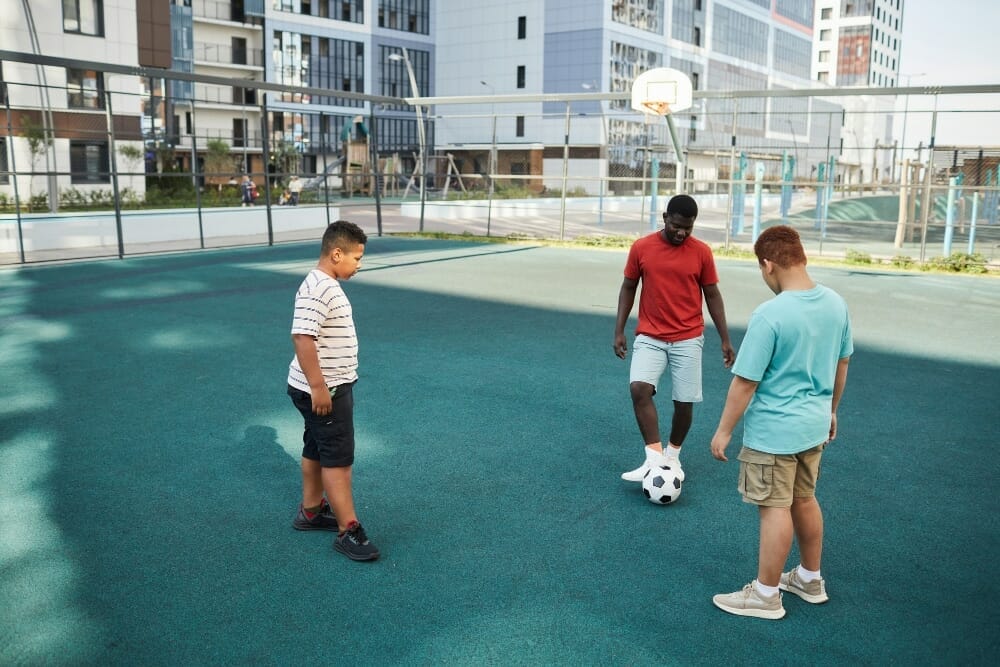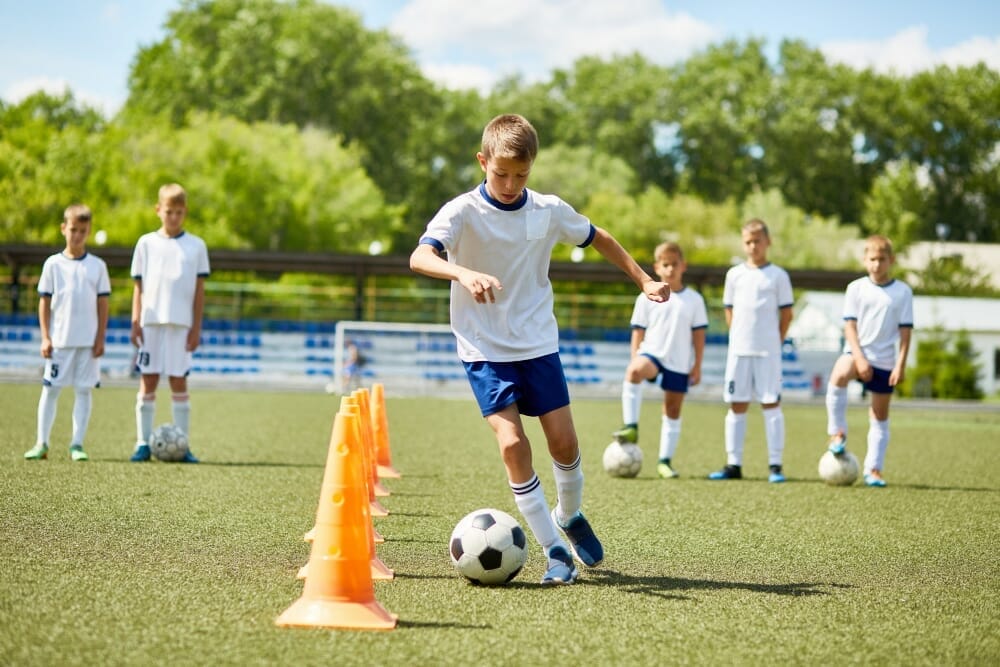Sports specialization is defined as intense, year-round training in a single sport with the exclusion of other sports. There is disagreement on what volume of training counts as “intense” and whether year-round participation or excluding other sports classifies an athlete as “specialized.”
Some researchers have varying definitions, but for this article, we will discuss children who start at an early age (elementary and middle school age), specialize and increase their sport participation (more than 8 months per year), make a full-time commitment, and train for the purpose of improved performance rather than enjoyment.1
The argument for sports specialization at a young age comes from a variety of thoughts and stories: professional athletes who played one sport growing up, middle school athletes being offered scholarships for college sports, thoughts that training in one sport will improve the sport more than playing multiple sports, or even parents who underwent the same training growing up.
Within the past 10 years, sports specializations have seen a dramatic increase, with over 77% of high school athletic directors reporting more children specializing, and travel leagues for 7- to 8-year-olds increasing as well.2

A survey of elite young athletes found that parents were the strongest influence on a child’s initiation in a sport.2 This majority makes sense, as it is often up to the parents or caretakers of a child to spend money on equipment and registration, drive them to practice and games, and encourage their participation on and off the field.
However, the survey also found that coaches were the strongest influence on the decision to perform intense training for one sport.2 As a child’s caretaker, this seems like a smart decision: the coach is often someone with years of experience playing and coaching the sport. I have had my own share of coaches who honed my skills in a sport and allowed me to improve with my teammates from their extensive knowledge and experience.
But how much do coaches know regarding a child’s training recommendations? Children have a different anatomy and biology that rapidly changes from birth to 18 years old, and expecting them to perform at a high level with no variation in their training can have worse outcomes for the season than expected. A questionnaire sent to over 250 youth coaches in one state found over 77% of them were unaware of recommendations regarding the maximum number of months per year, hours per week in one sport, or number of simultaneous leagues for an athlete to participate in to reduce injury.
Fewer than half of all coaches were “very” concerned about the risk of injury in youth sports, while 60% believed that sport specialization was a problem. Over two-thirds responded that year-round participation in a single sport was either “very” likely to increase an athlete’s risk of injury.3 So while a majority of coaches have their players’ best interests at heart, they often do not possess the knowledge of a child’s physical limitations due to their changing growth and anatomy.
While data has been tracked for other leisure activities, and has shown a correlation that musicians who spent over 10,000 hours of practicing over 10 years performed better than their peers with less time spent and those who began after age 5, there has been little consistent and large studies to show that early intense training translates to attaining elite level in a sport.2 What the limited research has shown is that only women’s rhythmic gymnastics benefitted from intense training before puberty as peak performance was attained before full maturation. Elite athletes in other sports were found to initiate intense training later than 16 years of age.2
It is notable to highlight there are several risks to single sport intense training that make it a poor choice for a child of any age, with the three main risks being injury, stress, and dropping out. Children competing at an international level are more likely to experience injury compared to those at a national or recreational level, according to a 10 year follow-up study. Children exceeding 16 hours of training per week have a significantly higher risk of injury. In tennis-only players, injury was 1.5 times more likely than multi-sport tennis players. Baseball pitchers (9-14 years old) who pitched more than 100 innings per year were 3.5 times more likely to be injured. Athletes older than 13 years of age and at higher competitive levels have higher rates of injury, as well as higher rates of fracture during periods of rapid height growth in teenagers.2
Early sports specialization in children has demonstrated higher rates of psychological stress and dropout from sports. Swimmers who specialized earlier were less likely to be on the national team and more likely to have retired earlier. Minor league ice hockey players dropped out of hockey started off-ice training earlier than those who continued to compete. Elite athletes have said their reasons for quitting have been injuries, lower overall health, less fun during sports, less input in their training, higher perceived parental criticism and expectations, difficult schedule loads, and lower levels of motivation.2 When a child competes well in a sport, it can be exciting to imagine them performing well in high school, college, and professionally.
But when that child feels this immense pressure to perform and obtain a level of athletic greatness, it can affect their mental health that cannot only ruin the sport and exercise for them, but can affect their stress management and mental health beyond their time playing in the sport. Children, adolescents, and teenagers should feel like their sport is an escape from their daily activities, not a burden.
You may be wondering at this point what has led to success for elite athletes later in life? Diversification. Athletes who played various individual and team sports as they grew up (ages 0-12) were provided with valuable physical, cognitive, and psychosocial environments, and they helped to promote motivation in the children. Less sports-specific practice helps to transfer “pattern recall skills” from one sport to another.2
Pattern recall skills are how bodies and minds can identify movement patterns for use in similar tasks. For example, a person exposed to rollerblading will have an easier time learning ice skating than someone who has not performed either, as the movements use similar muscles and motions. Research from people ranging in age from infants to senior citizens shows that variations in practice have a greater increase in skills than repetitive practice. Early diversification followed by sport specialization later in adolescence has been shown to lead to more enjoyment, fewer injuries, and longer participation.
This is not to say that it is impossible for one-sport athletes to reach an elite level. Soccer athletes who reached pro status by age 16 were found to have more unstructured soccer practices than their peers despite having the same practice, competition, and other sports. Elite tennis players often have good long-term relationships with the same coach, access to tennis courts, and less demands for success compared to their peers.2
The difference was these athletes were using their free time to play and practice on their own, presumably in between their school and family responsibilities.
With all of that in mind, how should you approach your child’s sports? The National Athletic Trainers’ Association makes the following recommendations regarding sport specialization4:
- Delay specializing in a single sport for as long as possible: it supports general physical fitness, athleticism, and reduces injury risk in athletes
- One team at a time: participate in one sport per season
- Less than 8 months per year
- No more hours/week than age in years: a 12 year old athlete should not participate in more than 12 hours per week of an organized sport
- Two days of rest per week: no participation in other organized team sports, competitions and/or training on rest and recovery days.
- Rest and recovery time from organized sport participation: spend time away from organized sport and/or activity at the end of each competitive season. This allows for both physical and mental recovery, promotes health and well-being, and minimizes injury risk and burnout/dropout.
The most important aspect should always be one word: FUN! Sports for children are meant to introduce children to a fun recreational activity, create new bonds and friendships, allow them an outlet for their energy, and teach them valuable lessons about life and teamwork. Are all aspects of life fun for a child? Absolutely not: doctor visits, following bedtimes, eating vegetables, and not getting the toy they want to name a few. Sports should be the chance for them to make the connection that exercising can be fun and sports can be a life-long joy.
If your child does sustain an injury from sports, whether it is overuse or traumatic injury, what should you do? If necessary, visit your child’s pediatrician or the emergency room to rule out any major concerns such as fractures, concussions, bleeding, etc.
Once these issues have been ruled out or addressed, seeking a physical therapist (specifically one who sees orthopedic, pediatric, or both types of patients) can help to decrease your child’s time to recovery and give them and the family tools to decrease the recurrence of similar injuries.
If your child has sustained an injury during their sport or off-season, reach out to KidSense Therapy Group to be scheduled with a physical therapist.
Resources
- Myer GD, Jayanthi N, Difiori JP, et al. Sport Specialization, Part I: Does Early Sports Specialization Increase Negative Outcomes and Reduce the Opportunity for Success in Young Athletes?. Sports Health. 2015;7(5):437-442.
- Jayanthi N, Pinkham C, Dugas L, Patrick B, Labella C. Sports specialization in young athletes: evidence-based recommendations. Sports Health. 2013;5(3):251-257. doi:10.1177/1941738112464626
- Post EG, Trigsted SM, Schaefer DA, et al. Knowledge, Attitudes, and Beliefs of Youth Sports Coaches Regarding Sport Volume Recommendations and Sport Specialization. J Strength Cond Res. 2020;34(10):2911-2919.
- https://www.nata.org/blog/beth-sitzler/youth-sports-specialization-recommendations

